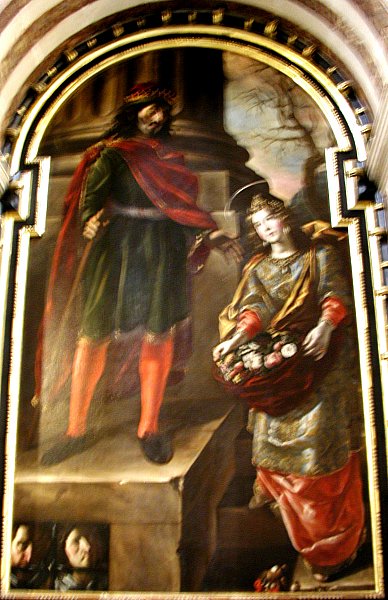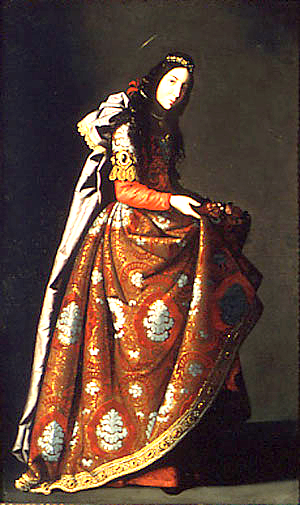Essentially, there are two quite separate stories. One centers on the purportedly healing waters of a pool in Briviesca, Burgos, that was associated for some reason with St. Vincent of Saragossa. Casilda was the daughter of the Moslem King of Toledo. The King's physicians had been unable to cure her from a flux of blood, but it was revealed to her that if she went to St. Vincent's pool she would be cured.
Her father obtained permission from the Christian king of Burgos for his daughter to pass safely to the pool, agreeing in return to free the Christian captives he had been holding. Along the way, as Casilda was crossing a bridge her horse was frightened by a demon and she fell into the water, but an angel came and rescued her. When she arrived at the pool, the waters did cure her, and considering all these miracles she took baptism and remained at the pool as an anchorite for the rest of her life.
Through the ensuing years women would come to the pool to be cured from a flux of blood. So far I have not found any images associated with this story.
The other story is set in the years before Casilda's pilgrimage to the pool. In it, she takes pity on the Christian captives that her father is holding in prison. Every day she brings them bread and meat folded up in the bosom of her garments. (According to one variant, she also has a serving girl accompany her with meat and bread in a basket.)
One day, her father stops her as she is leaving with the foodstuffs and asks what she is carrying. She says, "roses." He pulls at the folds in her clothing, and what he sees is indeed roses. He knows she is somehow tricking him, but she continues her daily missions and every time he stops her he sees only roses.
In the first picture at right, the artist has edited the serving girl out of the story and given the basket to Casilda.
Similar stories are told of St. Elizabeth of Hungary and St. Godelieve.
Prepared in 2014 by Richard Stracke, Emeritus Professor of English, Augusta University, revised 2015-10-14.

Santa Casilda ante su Padre (See the description page)

The problem of making Casilda look graceful with a load of stuff in her clothes was elegantly solved by Zurbarán in his 1635 portrait. (See the description page.)
ATTRIBUTES
- Foodstuffs or roses in a basket or folded into her skirt
DATES
- 11th century
NOTES
1 Acta Sanctorum, April vol. 1, 847-50. The sources include the Burgos Breviary, a letter to Rome petitioning (unsuccessfully) for Casilda's inclusion in the Roman Martyrology, an otherwise unspecified "Vita Hispanica," and the 17th-century Martyrolgium Hispanum by Juan Tamayo de Salazar.